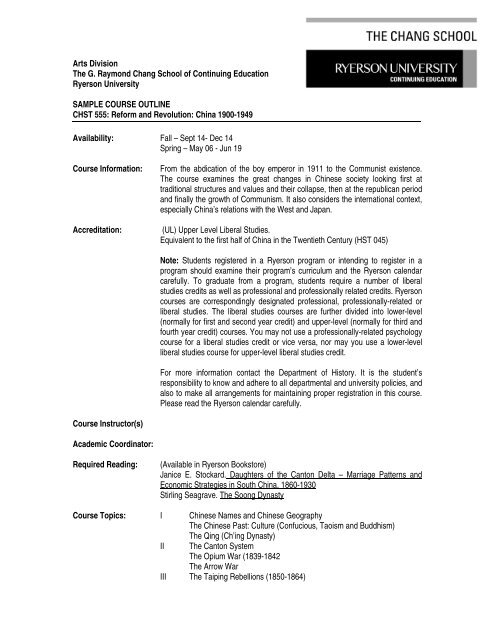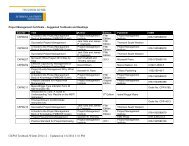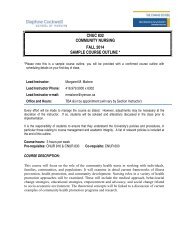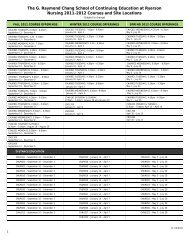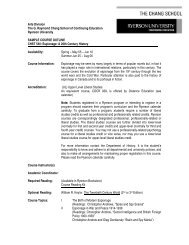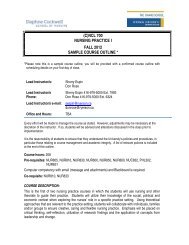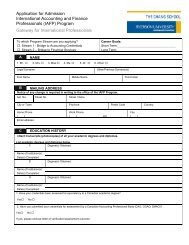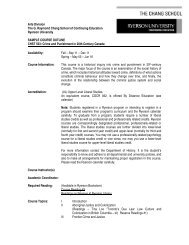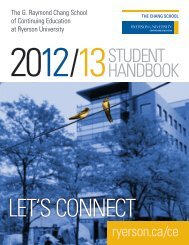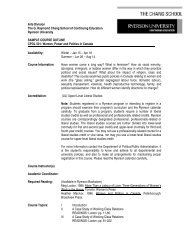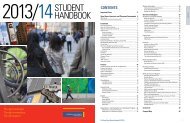CHST 555 - The Chang School - Ryerson University
CHST 555 - The Chang School - Ryerson University
CHST 555 - The Chang School - Ryerson University
Create successful ePaper yourself
Turn your PDF publications into a flip-book with our unique Google optimized e-Paper software.
Arts Division<br />
<strong>The</strong> G. Raymond <strong>Chang</strong> <strong>School</strong> of Continuing Education<br />
<strong>Ryerson</strong> <strong>University</strong><br />
SAMPLE COURSE OUTLINE<br />
<strong>CHST</strong> <strong>555</strong>: Reform and Revolution: China 1900-1949<br />
Availability: Fall – Sept 14- Dec 14<br />
Spring – May 06 - Jun 19<br />
Course Information:<br />
Accreditation:<br />
From the abdication of the boy emperor in 1911 to the Communist existence.<br />
<strong>The</strong> course examines the great changes in Chinese society looking first at<br />
traditional structures and values and their collapse, then at the republican period<br />
and finally the growth of Communism. It also considers the international context,<br />
especially China’s relations with the West and Japan.<br />
(UL) Upper Level Liberal Studies.<br />
Equivalent to the first half of China in the Twentieth Century (HST 045)<br />
Note: Students registered in a <strong>Ryerson</strong> program or intending to register in a<br />
program should examine their program’s curriculum and the <strong>Ryerson</strong> calendar<br />
carefully. To graduate from a program, students require a number of liberal<br />
studies credits as well as professional and professionally related credits. <strong>Ryerson</strong><br />
courses are correspondingly designated professional, professionally-related or<br />
liberal studies. <strong>The</strong> liberal studies courses are further divided into lower-level<br />
(normally for first and second year credit) and upper-level (normally for third and<br />
fourth year credit) courses. You may not use a professionally-related psychology<br />
course for a liberal studies credit or vice versa, nor may you use a lower-level<br />
liberal studies course for upper-level liberal studies credit.<br />
For more information contact the Department of History. It is the student’s<br />
responsibility to know and adhere to all departmental and university policies, and<br />
also to make all arrangements for maintaining proper registration in this course.<br />
Please read the <strong>Ryerson</strong> calendar carefully.<br />
Course Instructor(s)<br />
Academic Coordinator:<br />
Required Reading:<br />
(Available in <strong>Ryerson</strong> Bookstore)<br />
Janice E. Stockard. Daughters of the Canton Delta – Marriage Patterns and<br />
Economic Strategies in South China, 1860-1930<br />
Stirling Seagrave. <strong>The</strong> Soong Dynasty<br />
Course Topics: I Chinese Names and Chinese Geography<br />
<strong>The</strong> Chinese Past: Culture (Confucious, Taoism and Buddhism)<br />
<strong>The</strong> Qing (Ch’ing Dynasty)<br />
II <strong>The</strong> Canton System<br />
<strong>The</strong> Opium War (1839-1842<br />
<strong>The</strong> Arrow War<br />
III <strong>The</strong> Taiping Rebellions (1850-1864)
<strong>The</strong> Dynastic Revival<br />
IV <strong>The</strong> Sino-Japanese War (1895-1896)<br />
<strong>The</strong> Reform Movement of 1898<br />
V <strong>The</strong> Boxer Rebellion and Protocol (1900-1901)<br />
<strong>The</strong> Peaceful Penetration of China<br />
<strong>The</strong> Anti-American Boycott (1905-1906)<br />
<strong>The</strong> Anti-Japanese Boycott (1908)<br />
Lat Quing (Ch’ing) Reforms<br />
VI Dr. Sun Yat-sen and the Revolution<br />
<strong>The</strong> 1911 Revolution and the Manchu Abdication<br />
VII China under Yuan Shikai (Yuan Shih-k’ai)<br />
Japan’s Twenty-One Demands<br />
<strong>The</strong> Warlord Era<br />
VIII <strong>The</strong> May Fourth Movement<br />
<strong>The</strong> Birth of the Communist Party of China<br />
<strong>The</strong> First United Front<br />
IX <strong>The</strong> Nanjing (Nanking) Government (1927-1937)<br />
X <strong>The</strong> New Warlords<br />
Japanese Aggression in Manchuria and Shanghai<br />
XI <strong>The</strong> Chinese Communist Party (1927-1935)<br />
<strong>The</strong> Canton Commune<br />
XII <strong>The</strong> Xi’an (Sian) Incident (1936) and the Second United Front<br />
<strong>The</strong> Undeclared War with Japan (1937)<br />
<strong>The</strong> Nanjing (Nanking) Massacre (1937)<br />
XIII <strong>The</strong> Second World War<br />
<strong>The</strong> Civil War (1945-1949)<br />
Assignments & Exams Analytical essay – 25%; Analytical essay – 25%; Final Examination – 50%<br />
NOTE: Planned alterations in the list of course assignments, tests, approximate<br />
deadlines and in the marking or evaluation scheme, as they appear in the course<br />
outline shall be discussed in class prior to being implemented.<br />
<strong>CHST</strong> <strong>555</strong>: Reform and Revolution: China 1900-1949 / 2


